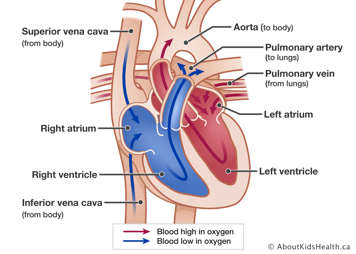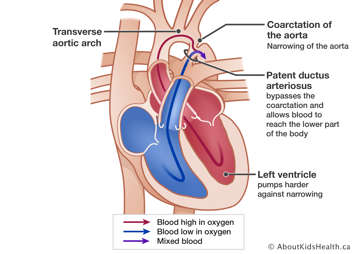What is coarctation of the aorta?
The aorta is the main artery that carries oxygenated blood from the left ventricle of the heart to the body. This supplies the body’s organs with blood.

Coarctation of the aorta means the aorta has a narrowing. This condition is congenital, meaning a person is born with it. It most commonly occurs in a small area of the aorta called the isthmus or ‘juxtaductal’ region. In some cases, longer sections of the aorta can also be narrowed. This is called transverse arch hypoplasia.
The narrowing of the aorta causes a blockage for blood leaving the left ventricle, which means the heart has to work harder to pump the blood through the aorta. In a baby, if the narrowing is very severe, it can cause the left ventricle to fail. A ductus arteriosus allows the blood to bypass the narrowed section of the aorta to reach the body. The ductus arteriosus is patent at birth and typically shrinks and closes within the first few days of life.

Sometimes, people with coarctation have other heart defects, such as a ventricular septal defect, or a bicuspid aortic valve.
How is coarctation diagnosed?
Coarctation of the aorta is present from birth, but the age when it’s diagnosed usually depends on how severe the narrowing of the aorta is. Babies may not have symptoms at birth and start developing symptoms when the ductus arteriosus closes. If the narrowing is severe, babies can become very sick within the first month of life and need admission to the hospital. If the narrowing is less severe, it may not be noticed for many months or even years. In an older baby, teenager or sometimes adult, a heart murmur or high blood pressure may be symptoms of an undiagnosed coarctation.
The diagnosis is most often confirmed by using an echocardiogram (heart ultrasound). A computed tomography (CT) or magnetic resonance imaging (MRI) scan, and occasionally a heart catheterization, may also be used to confirm diagnosis.
How is coarctation treated?
Treatment depends on how severe the narrowing of the aorta is. Babies with severe coarctation may have an operation to remove the narrowed section. An alternative option to surgery is a heart catheterization procedure.
During this procedure a thin, flexible tube called a catheter is inserted into a blood vessel in the groin that leads to the heart. A balloon is inflated inside the aorta to widen the narrowed area. Catheterizations are typically only for patients who are older than 3 months or for whom the coarctation is less severe. Sometimes, in older children a stent (small metal tube) is placed in the aorta to help keep the narrowed section open. As the child gets older, this stent may need to be dilated during a catheterization procedure.
Complications of coarctation of the aorta
Aortic coarctation, like all congenital heart disease, is a lifelong condition. While treatment is usually successful, some complications can develop. Therefore, it is important to keep seeing your cardiologist regularly as many of these complications can be detected before symptoms develop.
Re-coarctation
Sometimes, the narrowed area in the aorta comes back. This is called re-coarctation. If this happens, you may need another operation or a heart catheterization to open the narrowing. This happens in about 5% of patients. Re-coarctation can be detected by measuring the blood pressure in the arms and legs, or by echocardiogram, CT or MRI scan. The risk of re-coarctation is highest within the first year after surgery.
Hypertension
If you have a history of coarctation, you have a higher risk of developing high blood pressure (hypertension), even if the narrowed section of the aorta was repaired successfully. The blood pressure can be normal when resting but can become very high during exercise. High blood pressure can be detected by a machine which measures blood pressure for 24 hours. Medication may be needed to control blood pressure.
Aneurysms
Rarely, in some people with coarctation, aneurysms can develop in the aorta or the brain. Aneurysms are swollen blood vessels which sometimes become too big and possibly burst. This is a very serious and possibly life -threatening complication.
Aneurysms can be detected by echocardiogram, CT or MRI scans of the aorta or the brain. Routine visits to your cardiologist are important so that these problems can be diagnosed and treated early. Aneurysms are more common in people who had an aortic coarctation repair as adults or who have uncontrolled high blood pressure.
Endocarditis
Children with coarctation can be at risk of infection of the heart or aorta (endocarditis). If a stent was implanted or a graft was used to repair the coarctation, there is a risk of endocarditis for 6 months after the procedure. Antibiotics will be needed before certain medical or dental procedures.
Can I exercise normally if I’ve had an aortic coarctation?
Regular exercise is important to keep both the heart and the mind healthy. In the past, children and teens with congenital heart disease were often told not to exercise, or to not push too hard during exercise as the heart was weak.
However, it’s now known that for most people with congenital heart disease, regular exercise is beneficial to their overall health. Most children and teens who had a successful coarctation repair can exercise normally and participate in all competitive sports, with some exceptions.
- If you have had a recent surgery, you should wait 3 months before returning to sports. If you have had a catheterization, you should wait 1 month before returning to sports. Anyone with aneurysms in their aorta might not be able to participate in contact sports.
- Avoid high-intensity weightlifting, even if the coarctation repair was successful. Participation in lower volume weightlifting is allowed. As a general rule, it’s safe to choose a weight that can be performed in 10-12 repetitions over 3-4 sets. This type of exercise is called 'static' training.
Talk to your cardiologist or transition nurse to discuss safe participation in sports and activities.
Pregnancy, sexual health and coarctation
For most people who have had a successful repair of their coarctation, pregnancy is safe. However, for those with unrepaired coarctation, re-coarctation or aneurysms in the aorta, pregnancy may be very dangerous. Also, medications to control high blood pressure (e.g., ACE inhibitors) can be dangerous to a developing fetus.
Every pregnancy has some risk for complications which can be increased by an underlying cardiac defect. It's important to talk to your cardiologist even before trying to get pregnant. In general, unplanned pregnancy should be avoided and you should talk to your cardiologist, family doctor or transition nurse about contraception choices.
What method of contraception is recommended?
Your cardiologist, transition nurse or family doctor are the best people to talk to about contraception as they will know a lot about heart conditions.
Online resources such as www.iheartchange.org are also available.
The Canadian Paediatric Society recommends long-acting reversible contraceptives (LARCs) as the preferred contraceptive of choice for all teens in Canada, as they are the most effective. One of the reasons they are so effective is that you do not need to remember to take a pill every day. LARCs, including subdermal (under the skin) implants and intrauterine contraceptives (IUCs), are significantly more effective when used properly than oral contraceptives (birth control pill).
LARCs are safe for women with aortic coarctation. LARCs have to be inserted by a doctor who is trained in the procedure. LARCs are typically effective for 3 years. Usually, in individuals with repaired aortic coarctation, this procedure doesn’t have to be performed at a hospital, such as SickKids. It can be performed in a community health clinic.
Though LARCs are the most recommended form of contraception, alternative contraception options are also available. The combined oral contraceptive pill ('the pill') is generally safe for women with aortic coarctation, if they do not have high blood pressure. For those with high blood pressure, a version of the pill called the 'mini pill', which contains only the hormone progesterone, is a safer choice.
Regardless of contraception choice, a condom should always be used to reduce the risk for sexually transmitted infections (STIs). Once a person is sexually active, regular STI testing is recommended. It’s important for both partners to practise safe sex – it’s not just one person’s responsibility.
Emergency contraception such as 'the morning after pill' or 'Plan B' is safe for women with an aortic coarctation.
If I have children, will they have congenital heart disease too?
The risk for any person having a baby with congenital heart disease is about 1%. For babies born to a parent who has congenital heart disease, such as a coarctation, the chance that the baby will have any type of congenital heart disease is about 3%. This risk is for both men and women. That still means there is a 97% chance that the baby will not have congenital heart disease.
Parents with congenital heart disease can talk with a genetic counselor or genetic specialist before deciding to have children. An ultrasound scan of the fetus’s heart can be performed during the pregnancy to look for congenital heart disease.






